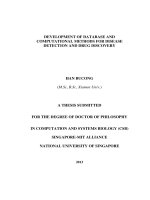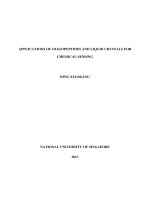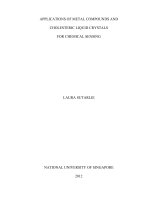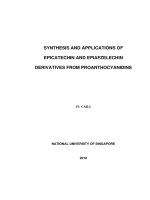Applications of oligopeptides and liquid crystals for chemical sensing
Bạn đang xem bản rút gọn của tài liệu. Xem và tải ngay bản đầy đủ của tài liệu tại đây (5.33 MB, 234 trang )
APPLICATIONS OF OLIGOPEPTIDES AND LIQUID CRYSTALS FOR
CHEMICAL SENSING
DING XIAOKANG
NATIONAL UNIVERSITY OF SINGAPORE
2013
APPLICATIONS OF OLIGOPEPTIDES AND LIQUID CRYSTALS FOR
CHEMICAL SENSING
DING XIAOKANG
(M. ENG., UNIV. SCI. & TECH. BEIJING)
A THESIS SUBMITTED
FOR THE DEGREE OF DOCTOR OF PHILOSOPHY
DEPARTMENT OF CHEMICAL AND BIOMOLECULAR
ENGINEERING
NATIONAL UNIVERSITY OF SINGAPORE
2013
DECLARATION
I hereby declare that this thesis is my original work and it has been written by me in
its entirety. I have duly acknowledged all the sources of information which have been used in
the thesis.
This thesis has also not been submitted for any degree in any university previously.
______________________________________
Ding Xiaokang
25 July 2013
1
ACKNOWLEDGEMENTS
First and foremost, I give my utmost gratitude to my supervisor, Prof.
Yang Kun-Lin, for his sincerity and encouragement. I will not be able to finish
my Ph.D study without his guidance. His integrity and passion in research
inspire me to hurdle all obstacles during the course of my research work.
I would like to express my appreciation to all lab members including
Dr. Chen Chih-Hsin, Dr. Bi Xinyan, Dr. Xue Changying, Dr. Zhang Wei, Dr.
Lai Siok Lian, Dr. Laura Sutarlie, Dr. Liu Fengli, Dr. Arumugam Kamayan
Rajagopalan G, Dr. Maricar Bungabong, Dr. Vera Joanne Retuya Alino, and
Ms Liu Yanyang, for their helpful discussion and suggestions in research.
Over the past five years, we work together and build strong friendship which
will last forever. In addition, I thank Prof. He Jianzhong and her group
members who provided generous help in my phage display research. Special
thank is given to Prof. Saif A. Khan and his group members for their valuable
feedback and suggestions in our group meeting. Gratitude is also given to lab
officers, e.g. Mr. Boey Kok Hong and Ms. Lee Chai Keng, for their invaluable
assistance.
Finally, I would like to thank my parents and my wife. They always
support me and encourage me during the past five years.
2
TABLE OF CONTENTS
ACKNOWLEDGEMENTS 1
TABLE OF CONTENTS 2
SUMMARY 7
LIST OF TABLES 10
LIST OF FIGURES 11
LIST OF SYMBOLS 17
LIST OF ABBREVIATIONS 18
CHAPTER 1 INTRODUCTION 1
1.1 Background 2
1.1.1 Principles of LC-Based Sensor 2
1.1.2 Detection of Aliphatic Amines 5
1.1.3 Detection of Neonicotinoids and Glyphosate Herbicide 6
1.1.4 Detection of Human Chorionic Gonadotropin (hCG) 8
1.1.5 New Amplification Mechanism of LC-Based Sensor 9
1.2 Research Objectives 10
CHAPTER 2 LITERATURE REVIEW 13
2.1 Sensing Layers Used in Sensors 14
2.1.1 Functional Molecules (Abiotic Molecules) 14
2.1.2 Molecular Imprinting 15
2.1.3 Antibodies 16
3
2.1.4 Oligopeptides 22
2.2 Surface Plasmon Resonance (SPR) 26
2.2.1 Principles of SPR Sensors 26
2.2.2 SPR Biosensors 28
2.3 Silver Enhancement 37
2.4 Liquid Crystal (LC) 40
2.5 Liquid Crystals for Detecting Proteins 43
2.6 Liquid Crystals for Detecting Small Molecules 47
CHAPTER 3 LIQUID CRYSTAL BASED OPTICAL SENSOR FOR
DETECTION OF VAPOROUS BUTYLAMINE IN AIR 49
3.1 Introduction 50
3.2 Experimental Section 53
3.3 Results and Discussion 58
3.3.1 Effect of LA Concentration 58
3.3.2 Responses to Butylamine Vapors 59
3.3.3 Specificity of the LC-based Optical Sensors to Other Volatile
Compounds 66
3.3.4 Comparison Between LC Sensor to Other Sensors 67
3.4 Conclusions 68
CHAPTER 4 OLIGOPEPTIDES FUNCTIONALIZED SURFACE
PLASMON RESONANCE BIOSENSORS FOR DETECTING
THIACLOPRID AND IMIDACLOPRID 69
4.1 Introduction 70
4
4.2 Experimental Section 72
4.3 Results and Discussion 79
4.3.1 Phage Display Results 79
4.3.2 Fluorescent Test for Binding Specificity 83
4.3.3 LC Sensors to Detect Thiacloprid and Imidacloprid 84
4.3.4 SPR Measurement 85
4.4 Conclusions 90
CHAPTER 5 DEVELOPMENT OF AN OLIGOPEPTIDE
FUNCTIONALIZED SURFACE PLASMON RESONANCE BIOSENSOR
FOR ONLINE DETECTION OF GLYPHOSATE 92
5.1 Introduction 93
5.2 Experimental Section 96
5.3 Results and Discussion 102
5.3.1 Immobilized Glyphosate on Glass Beads 102
5.3.2 Identification of the Glyphosate Binding Phage 104
5.3.3 SPR Biosensor for Detecting Glyphosate 107
5.4 Conclusions 111
CHAPTER 6 ANTIBODY-FREE DETECTION OF HUMAN CHORIONIC
GONADOTROPIN (HCG) BY USING LIQUID CRYSTALS 113
6.1 Introduction 114
6.2 Experimental Section 117
6.3 Results and Discussion 122
6.3.1 Selection of hCG Binding Phage 122
5
6.3.2 SPR Measurement 125
6.3.3 Fluorescent Test for Oligopeptide-hCG Binding 128
6.3.4 Label-free Detection of hCG by Using LC 130
6.4 Conclusions 134
CHAPTER 7 ENZYMATIC SILVER DEPOSITION TO ENHANCE
LIQUID CRYSTAL SIGNAL 136
7.1 Introduction 137
7.2 Experimental Section 139
7.3 Results and Discussion 142
7.3.1 Immobilization of SA-ALP 142
7.3.2 Enzymatic Reaction Kinetics of SA-ALP 143
7.3.3 Enzymatic Silver Deposition to Enhance LC Signal 146
7.4 Conclusions 150
CHAPTER 8 CONCLUSIONS AND RECOMMENDATIONS 151
8.1 Conclusions 152
8.2 Recommendations 155
BIBLIOGRAPHY 158
APPENDICES 194
Appendix A 194
A.1 Determination of butylamine concentration in vapor phase 194
A.2 Effect of LA on the orientations of LC at LC/air interfaces 195
A.3 Effect of LA on the orientations of LC at LC/glass interfaces 197
6
A.4 Role of water in the optical reversibility of LC sensor 199
Appendix B 201
B.1 Fluorescence test for binding specificity 201
B.2 Surface density conversion 202
Appendix C 204
C.1 Phage display results of third, fourth and fifth round biopanning . 204
C.2 SPR experiments using scrambled oligopeptide 205
C.3 Surface density of FITC-labeled hCG 206
Appendix D 208
D.1 Molecular Weight of SA-ALP 208
D.2 Cy3-labelling of SA-ALP 209
D.3 Surface Density of SA-ALP 210
LIST OF PUBLICATIONS 212
7
SUMMARY
Detecting small molecules and biomarkers is important in
environmental monitoring, food safety, and medical diagnosis. Traditionally,
chromatography methods (such as HPLC or GC) and enzyme-linked
immunosorbent assay (ELISA) methods are used to detect target molecules.
However, these methods require sophisticated instrumentation or tedious
procedure. In Chapter 3, we developed a liquid crystal (LC)-based optical
sensor to detect vaporous butylamine in the air. This LC sensor doped with
lauric aldehyde (LA) shows fast and distinct bright-to-dark optical response to
butylamine vapor. For example, when the LA doping concentration is 0.1 wt%,
the LC shows a rapid bright-to-dark optical response within 2 min after it is
exposed to 10 ppmv (parts per million by volume) of butylamine. This optical
response is attributed to an orientational transition of LC triggered by a
reaction between LA and butylamine. This LC sensor also exhibits
reversibility after the sensor is exposed to open air because the reaction
between lauric aldehyde and butylamine is reversible. In addition to primary
amines (such as butylamine and octylamine), this LC-based sensor also
responds to secondary amines (such as diisopropylamine), but the detection
limit is 200 ppmv, which is much higher than butylamine. For specificity, this
LC sensor does not respond to vapors of water, ethanol, acetone, and hexane.
However, this sensor can also respond to other amines such as
diisopropylamine (DIPA) and octylamine. To improve specificity, more
selective sensing layers are needed.
8
In Chapter 4, we identified two highly specific oligopeptide sequences
RKRIRRMMPRPS and RNRHTHLRTRPR for binding to neonicotinoids
such as thiacloprid and imidacloprid, by using phage display library. The
former oligopeptide shows high affinity for thiacloprid whereas the latter
shows high affinity for imidacloprid. Surprisingly, cross binding is minimal
despite the similarity in molecular structure of thiacloprid and imidacloprid.
These two oligopeptides are also immobilized on the surface of a surface
plasmon resonance (SPR) chip to develop a neonicotinoid biosensor. This
oligopeptide functionalized SPR biosensor can rapidly detect thiacloprid and
imidacloprid in buffer solutions in a real-time manner. The limit of detection
(LOD) for thiacloprid and imidacloprid is 1.2 μM and 0.9 μM respectively.
In Chapter 5, we developed a biosensor for detecting a herbicide,
glyphosate. However, glyphosate is highly soluble and the original phage
display method cannot be applied. To address this issue, we developed a
modified phage display screening method by immobilizing glyphosate on
glass beads. By using this method, we successfully identified a 12-mer
oligopeptide sequence, TPFDLRPSSDTR, which binds to glyphosate
specifically. To develop a biosensor for detecting glyphosate, a gold SPR
sensor chip is modified with an oligopeptide, TPFDLRPSSDTRGGGC. This
SPR biosensor can rapidly detect glyphosate in PBS buffer in a real-time
manner. This biosensor also shows good specificity, and the LOD of this
biosensor can reach 0.89 µM.
The above studies were focused on detection of small molecules.
However, small molecules do not disrupt LC orientation easily. To develop a
sensor by combining LC and oligopeptide, we aim to detect a large
9
biomolecule such as human chorionic gonadotropin (hCG). We identified a
linear oligopeptide, PPLRINRHILTR, which can bind to hCG specifically.
Furthermore, we use liquid crystal (LC) to detect binding signal. The detection
principle is based on the disruption of LC by hCG, which binds to the surface-
immobilized oligopeptide. This disruption leads to distinct optical transition
visible to the naked eye. The LOD of this method is approximately 1 IU/mL (2
nM), and only 0.6 μL of hCG solution is required for each spot, which means
that as little as 45.5 pg of hCG can be detected by using this method. This LC-
based optical sensor is a testimony of the novel principle for detecting
biomolecules, and has high potential to be developed as portable diagnostic
devices.
However, we note that the LOD of the LC-based optical sensor for
hCG detection is 1 IU/mL (2 nM), which is not sufficient for early pregnancy
test (which requires a LOD of 20 mIU/mL). To improve the LOD, a key step
is to find a mechanism to further amplify the oligopeptide-protein binding
signal. Thus, enzymatic silver deposition is chosen to enhance the optical
response of the LC
1
. To achieve this goal, we first immobilize biotinylated
oligopeptide (PPLRINRHILTRGGG-biotin) on the glass slide surface. Then
the streptavidin-alkaline phosphatase (SA-ALP) is conjugated to promote in
situ silver deposition on the surface. After a thin layer of silver particle is
deposited to the glass slide surface, the LC orientation can be disrupted by the
silver layer, and thus the LC signal can be amplified. As a result, this
mechanism has the potential to amplify the presence of protein or oligopeptide
on the surface. We show that the LOD of SA-ALP is improved 3.3-fold after
silver deposition. This result is presented in the last chapter.
10
LIST OF TABLES
Table 2.1 SPR biosensors for detection of small molecules in medical
diagnosis, environmental monitoring and food quality control using indirect
inhibition immunoassays 34
Table 3.1 Comparison of LODs between LC sensors and other sensors 67
Table 4.1 Oligopeptide sequences and physical properties* identified from
phage screening experiments against thiacloprid and imidacloprid after 3
panning rounds 81
Table 4.2 Amino acid hydropathy scale 82
Table 4.3 SPR responses in control experiments 88
Table 4.4 Comparison of LOD between oligopeptide-based SPR sensors and
other sensors 90
Table 5.1 Comparison of LODs between oligopeptide-based SPR sensors and
other sensors to detect glyphosate 111
Table 6.1 Oligopeptide sequences binding to hCG and their physical
properties obtained from fifth round of phage display biopanning. 124
Table 6.2 Binding affinity of selected phages to hCG. 124
Table 6.3 Performance of SPR for hCG detection by using different
oligopeptides 126
Table 6.4 Comparison of LODs between oligopeptide-based LC sensors and
other sensors to detect hCG 133
Table 7.1 Determination of k
2
*
and k
2
at different concentrations of AH
2
and
silver ions at 37°C. 144
Table A.1 The relationship between butylamine vapor concentration (ppmv)
and initial concentration of butylamine (wt%) in aqueous solution with
interval of 10 ppmv 195
Table C.1 Oligopeptide sequences binding to hCG and their physical
properties obtained from (A) third round, (B) fourth round, and (C) fifth round
of phage display biopanning 204
11
LIST OF FIGURES
Figure 1.1 Schematic illustration of liquid crystal orientational transition (A)
before and (B) after exposure to small molecule weight target compounds 3
Figure 2.1 Schematic illustration of direct competitive radioimmunoassay
using
125
I-labeled β-hCG as a marker to detect hCG in serum. 18
Figure 2.2 Schematic illustration of “sandwich-type” immunoassay using
fluorescent-labeled anti-α-hCG as a marker to detect hCG in serum. 20
Figure 2.3 Synthetic scheme of imidacloprid haptens. 21
Figure 2.4 Schematic illustration of (A) Otto configuration, and (B)
Kretschmann configuration, to excite surface plasmons using a prism coupler. 27
Figure 2.5 Schematic illustration of SPR experimental setup. 28
Figure 2.6 Schematic illustration of four detection formats used in SPR
biosensors: (A) direct detection; (B) sandwich detection format; (C)
competitive detection format; (D) inhibition detection format. 29
Figure 2.7 Schematic illustration of silver staining method in immunoassay. 38
Figure 2.8 Schematic illustration of silver deposition and silver stripping to
enhance electrochemical signal for detection of DNA
214
. 39
Figure 2.9 Schematics illustration of enzymatic silver deposition.
1
40
Figure 2.10 The arrangement of molecules in liquid crystal phases. (A)
nematic phase, (B) cholesteric phase, and (C) smectic phase. 41
Figure 2.11 Molecular structure of 4-cyano-4′-pentylbiphenyl (5CB). 42
Figure 2.12 Schematic illustration of liquid crystal orientations and optical
appearances. 43
Figure 2.13 Orientations of LC at patterned glass slide surface. (A) uniform
LC orientation, (B) uniform LC orientation after immobilization of
ribonuclease, and (C) disrupt LC orientation after applying ribonuclease
inhibitor. 44
Figure 2.14 (A) Optical images of 5CB in a glass cell fabricated by DMOAP-
coated slides. One of the slides was patterned with circular domains of protein
IgG in an array format. The number shown above each circle indicates the
12
concentration (µg/mL) of the protein solution applied to the surface. (B)
Schematic illustration of LC orientation disrupted by protein. 46
Figure 3.1 A gas detection chamber used in this study. The volume of the
chamber is ~ 25 mL. LA-doped 5CB is dispensed in a copper grid supported
on a clean glass slide. The vapor is injected into the chamber by using a 200-
mL syringe. 55
Figure 3.2 Effect of LA doping concentrations on the optical images (top) and
orientations (bottom) of LC confined copper grids. The LA concentration
ranges from 0% to 2.0% as indicated on top of each image. All the images
were taken 2 h after sample preparation. Scale bar, 250 μm. 59
Figure 3.3 Optical images of LC sensors with LA doping concentration of 0,
0.001, 0.01, 0.05, and 0.10 wt% when they were exposed to butylamine vapors.
The vapor concentration of butylamine is indicated on the top of each image.
All the images were taken after stabilized for 30 min at room temperature.
Scale bar, 250 μm. 60
Figure 3.4 Optical images of LC sensors with LA doping concentration of 1.0,
2.0, and 4.0 wt% when they were exposed to butylamine vapors. The vapor
concentration of butylamine is indicated on the top of each image. All the
images were taken after stabilized for 30 min at room temperature. Scale bar,
250 μm. 60
Figure 3.5 (A) Orientational transition of LC at the LC/glass interface when a
LC sensor doped with 0.1 wt% of LA is exposed to 10 ppmv of butylamine.
(B) Orientational transition of LC at the LC/air interface when a LC sensor
doped with 1.0 wt% LA is exposed to 20 ppmv of butylamine. 62
Figure 3.6 Optical images of 5CB doped with imine product with
concentration of 0.1, 0.01, 0.001, and 0.0001 wt%. Scale bar, 250 μm. 63
Figure 3.7 ESI-MS spectrometry of 5.0 wt% LA-doped 5CB after exposing to
butylamine vapor for overnight. 64
Figure 3.8 Reversible optical responses of the LC sensors to butylamine with
(A) 0.1 wt%, and (B) 1.0 wt% of doping LA concentration in LC. Butylamine
concentrations are 10 ppmv and 20 ppmv, respectively. The light intensity is
the average value of nine compartments in a copper grid. 65
Figure 3.9 Optical images of the optical sensors with LA doping
concentration of 0.1 wt% (above) and 1.0 wt% (below) in LC after the
samples were exposed to 1000 ppmv of water, ethanol, acetone, and hexane,
200 ppmv of DIPA, and 20 ppmv of octylamine vapors respectively. All the
images were taken after the samples are stabilized for 1h at room temperature.
Scale bar, 250 μm. 66
13
Figure 4.1 Schematic illustration of the phage display screening protocol for
identifying peptides binding to thiacloprid or imidacloprid molecules. (1) A
phage library is incubated with molecular forms of neonicotinoids (thiacloprid
or imidacloprid), (2) washing with TBST buffer to remove non-specific bind
phages, (3) elute the binding phages by lowering the pH, (4) amplify the
eluted phage with E. coli culture, (5) repeat the screening with amplified
phage another two times for the strongest binding phages, (6) purification of
phage colony with plate titering, (7) DNA sequencing. 76
Figure 4.2 Schematic illustration for the design of each flow cell on SPR
sensor chip 79
Figure 4.3 Fluorescent images of thiacloprid and imidacloprid powders bind
to oligopeptide P
1
and P
2
, respectively. 83
Figure 4.4 Optical appearance of LC sensor after incubating in PBS buffer
solution containing saturated (A) thiacloprid and (B) imidacloprid. The
circular areas are immobilized with 100 µg/mL of Cys-P
1
and Cys-P
2
. 84
Figure 4.5 (A) Response of a Cys-P
1
modified SPR gold chip to 10μM of
thiacloprid (solid) and 10μM of imidacloprid (dashed), and (B) Binding curve
of Cys-P
1
modified SPR gold chip to HBS-EP buffer containing thiacloprid
with concentration of 2, 10, 20, 40, 60, 80, and 100 μM. The error bars
represent the standard deviation of three measurements. 86
Figure 4.6 (A) Response of a Cys-P
2
modified SPR gold chip to 10μM of
thiacloprid (solid) and 10μM of imidacloprid (dashed), and (B) Binding curve
of Cys-P
2
modified SPR gold chip to HBS-EP buffer containing imidacloprid
with concentration of 2, 10, 20, 40, 60, 80, and 100 μM. The error bars
represent the standard deviation of three measurements. 87
Figure 4.7 (A) The relationship of SPR final responses when HBS-EP buffer
containing thiacloprid with concentration of 2, 10, 20, 40, 60, 80, and 100 μM
flows over Cys-P
1
modified surface. (B) The relationship of SPR final
responses when HBS-EP buffer containing imidacloprid with concentration of
2, 10, 20, 40, 60, 80, and 100 μM flows over Cys-P
2
modified surface. The
error bars represent the standard deviation of three measurements. 88
Figure 5.1 Schematic illustration for the immobilization of glyphosate on
amine-modified glass beads by using EDC/NHS chemistry. 98
Figure 5.2 Schematic illustration of using phage library for screening
glyphosate-binding oligopeptides. (1) A phage library is incubated with glass
beads functionalized with glyphosate, (2) elute the bound phages by lowering
pH, (3) expose the phage to APES-coated glass beads for negative selection,
(4) collect the phages that do not bind to the glass beads, (5) amplify the
surviving phages, (6) repeat the screening procedure with amplified phage, (7)
14
purification of phage colony with plate titering, and (8) DNA sequencing and
deducing oligopeptide sequence from codon table. 99
Figure 5.3 Determination of surface free amine density on the glass beads by
using fluorescence method. (A) Fluorescence images of the glass beads after
silanization at different APES concentrations, as indicated in the numbers
below. The scale bar is 100 μm. (B) Surface free amine density as a function
of APES concentration 103
Figure 5.4 Determination of surface glyphosate density on the glass beads by
using fluorescence method. (A) Fluorescence images of the glass beads after
immobilization of glyphosate at different glyphosate concentrations, as
indicated in the numbers below. The scale bar is 100 μm. (B) Surface
glyphosate density as a function of glyphosate concentration. 104
Figure 5.5 (A) Oligopeptide sequences identified by using phage library
screening against glyphosate-functionalized glass beads after 3 rounds. (B)
Binding ratio of selected phage colonies to glyphosate-immobilized glass
beads and plain glass beads. The phage colonies used in this experiment are
isolated single-phage colonies which express oligopeptides P
1
, P
2
, P
3
, P
4
, P
5
or random oligopeptides. The error bar represents a standard deviation of three
parallel experiments. 106
Figure 5.6 (A) SPR sensorgrams for different concentrations of glyphosate (0,
2, 4, 8, 16, 32, and 64 μM). The sensor chip is modified with P
1
-cys with a
surface density of 0.6 molecule/nm
2
. (B) SPR responses at various glyphosate
concentrations. The inset shows a linear response region when the glyphosate
concentration is below 5 μM. (C) Fitting SPR signal response R vs (-R/C) by
using Langmuir isotherm. (D) SPR responses to 16 μM of glyphosate, glycine,
thiacloprid, and imidacloprid by using a sensor chip decorated with either P
1
-
cys or P
m
-cys. 109
Figure 5.7 SPR results showing factors that influence the binding strength of
oligopeptide to glyphosate. (A) effect of ionic strength and (B) effect of pH. 110
Figure 6.1 (A) SPR binding sensorgrams for detecting hCG in HBS-EP buffer
by using a P
4
functionalized sensor chip. The hCG concentrations are 0, 100,
200, 400, 800, and 1600 (mIU/mL), respectively. (B) Comparison of SPR
responses to hCG by using sensor chips modified with different oligopeptides. 125
Figure 6.2 (A) SPR binding sensorgrams for an inhibition assay using HBS-
EP buffer containing 1000 mIU/mL (2 nM) of hCG and different
concentrations of free P
4
. The sensor surface was also modified with P
4
. (B)
Average SPR responses to hCG at different concentrations of free P
4
. The
error bar indicates standard deviation of three measurements. 128
Figure 6.3 Fluorescence test for binding specificity of oligopeptide P
4
immobilized on a streptavidin-coated surface. The surface was incubated in (A,
15
C, D) FITC-hCG and (B) FITC-IgG. (C-D) are control experiments in which
the surface was only modified with (C) streptavidin and (D) no protein, to test
nonspecific adsorption of FITC-hCG. The concentration of FITC-hCG is 100
mIU/mL, and the concentration of FITC-IgG is 0.2 nM. The scale bar is 1 mm. . 129
Figure 6.4 Effect of FITC-hCG concentration on the fluorescent intensity. 130
Figure 6.5 Application of LC for testing the binding specificity of hCG to
oligopeptide P
4
immobilized on a streptavidin-coated surface. The surface was
incubated in (A, C, D) hCG and (B) IgG. (C-D) are control experiments in
which the surface was only modified with (C) streptavidin and (D) no protein,
to test nonspecific adsorption of hCG. The concentration of hCG is 10 IU/mL,
and the concentration of IgG is 20 nM. The image was an LC cell under
crossed polarizers. The scale bar is 1 mm 131
Figure 6.6 LOD of the LC-based hCG assay and effect of immobilized
oligopeptide density. The oligopeptide concentrations used during
immobilization are (A) 10 μg/mL (B) 5 μg/mL (C) 1 μg/mL and (D) 10 μg/mL.
Concentrations of hCG are 0, 0.1, 1, 10, and 50 IU/mL (from left to right).
hCG was dissolved in (A-C) PBS buffer and (D) urine. Scale bar is 1 mm. 134
Figure 7.1 Fluorescent images of Cy3-labeled SA-ALP immobilized on (A)
biotinylated oligopeptide modified surface, and (B) DMOAP surface. The
scale bar is 500 µm. 143
Figure 7.2 Lineweaver-Burk plot for determination of V
max
and K
m
of
SA−ALP on a solid surface (open circles) and in bulk solution (solid circles).
The error bar indicates the standard deviation of three measurements. 146
Figure 7.3 Schematic illustration of a possible mechanism to enhance LC
signal by using enzymatic silver deposition. (A) Before silver deposition, and
(B) after silver deposition. 147
Figure 7.4 Optical images of LC supported on glass slide immobilized with
SA-ALP before silver deposition. The concentrations of SA-ALP are denoted
above the image. The scale bar is 2 mm. 147
Figure 7.5 Optical images of LC supported on glass slide immobilized with
SA-ALP after silver deposition. The concentrations of SA-ALP are denoted
above the image. The scale bar is 2 mm. 148
Figure 7.6 SEM images of silver particles deposited on glass slides
immobilized with 0.20 molecule/nm
2
of P-biotin. Enzymatic silver deposition
was carried out after the slides were incubated in solution containing (A) 10
ng/mL, (B) 100 ng/mL, and (C) 500 ng/mL of trypsin. (D) is a magnified view
of (A) with 3-times higher magnification. Individual silver particles can be
seen clearly. 149
16
Figure 7.7 Images of glass slides after enzymatic silver deposition. The
concentrations of SA-ALP are denoted above the image. The scale bar is 2
mm. 150
Figure A.1 Optical images (top) and corresponding interfacial orientational
profiles (bottom) of a thin layer of LC containing pure 5CB, or 5CB doped
with 0.1, 0.5, 1.0 and 2.0 wt% LA. The thin layer of LC has a thickness of ~
20 µm and is in contact with air at both sides. All the images were taken after
the samples are stabilized for 2h at room temperature. Scale bar, 250 μm. 197
Figure A.2 Optical images (top) and corresponding interfacial orientational
profiles (bottom) of a thin layer of LC containing pure 5CB, or 5CB doped
with 0.1, 0.5, 1.0 and 2.0 wt% LA. The thin layer of LC has a thickness of ~
20 µm and is in contact with glass at both sides. All the images were taken
after the samples are stabilized for 2 h at room temperature. Scale bar, 1000
μm. 198
Figure A.3 Optical evolution of dehydrated 5CB doped with 0.1 wt% LA in
open air (top row) and desiccator (bottom row) after exposed to 10 ppmv
butylamine. 200
Figure B.1 Fluorescence images of the glass beads bind to FITC-labeled
oligopeptide. The glass beads used in this experiment are (A) plain glass beads,
(B) glycine-immobilized glass beads, and (C) glyphosate-immobilized glass
beads. The fluorescent intensities indicate the amount of oligopeptides binding
to different substrates. The scale bar is 100 μm. 202
Figure B.2 Calibration curve to convert fluorescence intensity to surface
density of FITC molecules. The unit of 1/nm
2
presents the number of FITC
molecules per nm
2
. 203
Figure C.1 SPR binding sensorgrams of hCG in HBS-EP buffer solution on
scrambled oligopeptide (TPFDLRPSSDTRGGGC) immobilized sensor chip.
The hCG concentration in HBS-EP buffer solution is 1600 mIU/mL. 206
Figure C.2 (A) Fluorescence images of the FITC-hCG spots with
concentration of 2, 10, 20, 40, 80, and 120 mIU/mL (from left to right). Scale
bar is 1 mm. (B) Calibration curve for the fluorescence intensities against the
surface density of FITC-hCG. 207
Figure D.1 (A) SDS-PAGE analysis to calculate the molecular weight of SA-
ALP. The left lane is molecular weight marker (M), and the right lane (S) is
SA-ALP sample. Two bands A and B were indicated in the sample lane. (B)
Linear fitting of log (MW) vs. distance to determine the molecular weight of
two subunits of SA-ALP. 209
17
LIST OF SYMBOLS
n
o
Ordinary refractive index
n
e
Extraordinary refractive index
V
m
Molar volume
M
Molar mass
ρ
Density
Γ
Surface density
N
A
Avogadro’s number
A
Area
C
Concentration
V
Volume
k
Reaction rate constant
v
Reaction rate
K
m
Michaelis constant
k
cat
Turnover number
k
on
Association rate
k
off
Dissociation rate
K
D
Equilibrium dissociation constant
18
LIST OF ABBREVIATIONS
5CB
4-cyano-4′-pentylbiphenyl
AFP
Alpha-Fetoprotein
AH
2
Ascorbic acid
AH
2
-p
Ascorbic acid 2-phosphate
ALP
Alkaline phosphatase
APES
(3-aminopropyl)triethoxysilane
BSA
Bovine serum albumin
DIPA
Diisopropylamine
DMMP
Dimethyl methylphosphonate
DMOAP
N,N-dimethyl-n-octadecyl-3-aminopropyltrimethoxysilyl chloride
DMSO
Dimethyl sulfoxide
DNT
2,4-dinitrotoluene
EDC
Ethyl(dimethylaminopropyl) carbodiimide
EDTA
Ethylenediaminetetraacetic acid
ELISA
Enzyme-linked immunosorbent assay
EPSPS
5-enolpyruvylshikimate-3-phosphate synthase
ESI-MS
Electrospray ionization mass spectrometry
19
FITC
Fluorescein isothiocyanate isomer I
GC
Gas chromatography
hCG
Human Chorionic Gonadotropin
HPLC
High-performance liquid chromatography
LA
Lauric aldehyde
LC
Liquid crystal
NHS
N-Hydroxysuccinimide
PBS
Phosphate buffer saline
PEG
Polyethylene glycol
PSA
Prostate Specific Antigen
QCM
Quartz crystal microbalance
SA-ALP
Streptavidin-labeled alkaline phosphatase
SAMs
Self-Assembly Monolayers
SDS
Sodium Dodecyl Sulfate
SPR
Surface plasmon resonance
TBS
Tris-buffered saline
TNT
2,4,6-trinitrotoluene
X-gal
5-bromo-4-chloro-3-indolyl-β-D-galactoside
Chapter 1.
1
CHAPTER 1
INTRODUCTION
Chapter 1.
2
1.1 Background
1.1.1 Principles of LC-Based Sensor
Principles of using liquid crystals (LCs) for protein sensing have been
developed over the past decades. Gupta et al.
2
first described a principle of
building a protein sensor by using LC. Briefly, protein is first immobilized on
a solid surface. This thin layer of protein can disrupt the LC orientation at the
solid/LC interface, and the interfacial orientational change of the LC can
propagate into the bulk of LC over several micrometers due to their long-range
interactions. Then, the orientational transition of bulk LC can be transduced
into optical signals which can be easily visualized with ambient light and the
naked eye due to the birefringence of LC. Later, Shah and Abbott
3
developed
an LC-based optical sensor for detection of small molecules, such as
organoamines and organophosphorus. Unlike biomolecules such as proteins or
DNAs, small molecules cannot disrupt LC orientation easily. To address this
issue, self-assembled monolayers (SAMs) of carboxylic acid (COOH)-
terminated thiols were immobilized on a thin layer of gold film patterned with
nanometer-scale topography, and pretreated with copper perchlorate. In this
case, the LC molecules are perpendicular to the substrate surface due to the
interaction between nitrile groups of LC molecules and Cu
2+
which bound to
SAM receptors, as shown in Figure 1.1A. Once the SMA modified substrate is
exposed to a target molecule, such as dimethyl methylphosphonate (DMMP),
the target molecules bind to Cu
2+
on SAM receptors to displace LC from its
weak complex with Cu
2+
, and the LC orientation changes from perpendicular
to parallel to the nano-structured substrate surface, as shown in Figure 1.1B.
Chapter 1.
3
This orientational transition of LC leads to an optical transition from dark to
bright when the sample is observed under a microscope equipped with a pair
of crossed polarizers.
Figure 1.1 Schematic illustration of liquid crystal orientational transition (A)
before and (B) after exposure to small molecule weight target compounds.
Two design rules for the LC-based sensors have been established in the
work mentioned above. The first rule is that LC should be pre-orientated
uniformly before exposing to target analytes. Previously, uniform planar
2, 3
orientation of LC is used. The orientational transition of LC from uniform
planar to homeotropic can be distinguished by using microscope equipped
with a pair of crossed polarizers, and optical response of LC can be observed.
However, the optical response of LC is dependent on the sample position (or
angle) in the light field. Besides, it is difficult to quantify the differences
between uniform and random orientation of LC. To overcome these
limitations, in previous studies of our group, LC sensors were developed from
homeotropic-pretreated LC orientation
4-6
. For example, on a N,N-Dimethyl-
N-octadecyl-3-aminopropyltrimethoxysilylchloride (DMOAP)-coated glass
slide, the LC orientation is homeotropic, and the optical appearance of LC is
dark. Once the glass slide is immobilized with protein molecules, the









